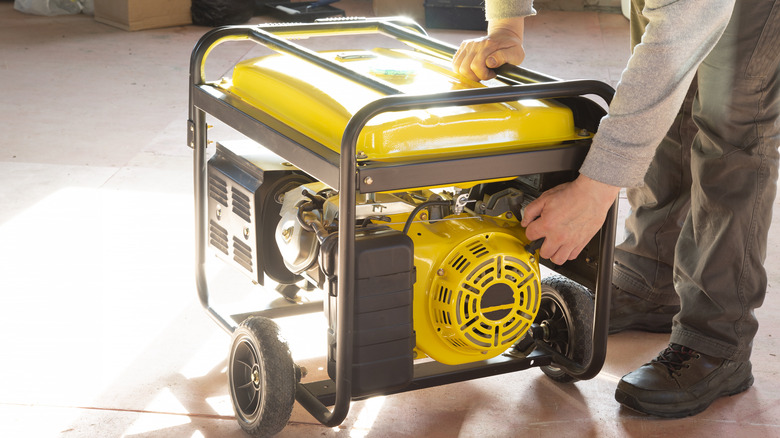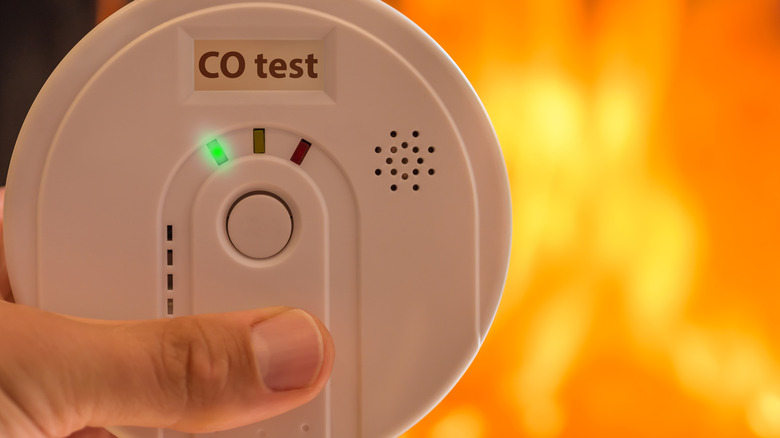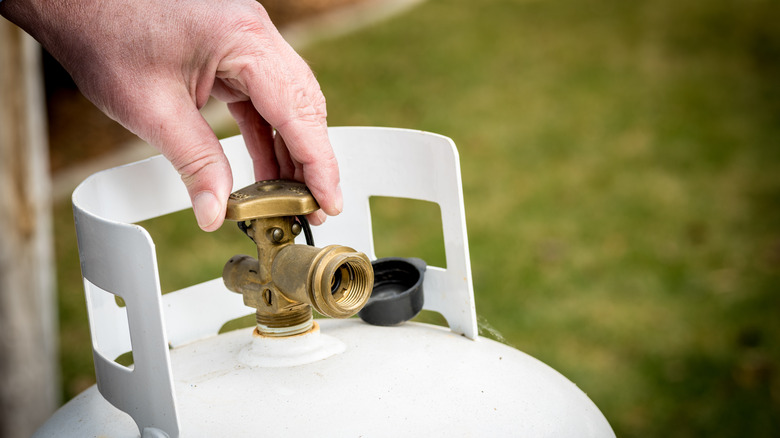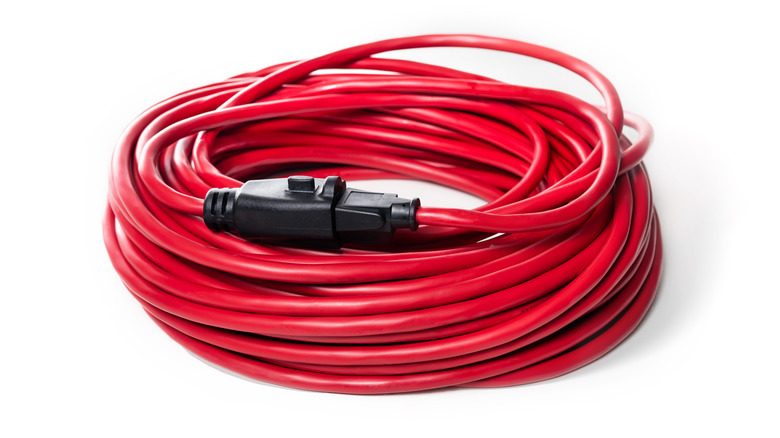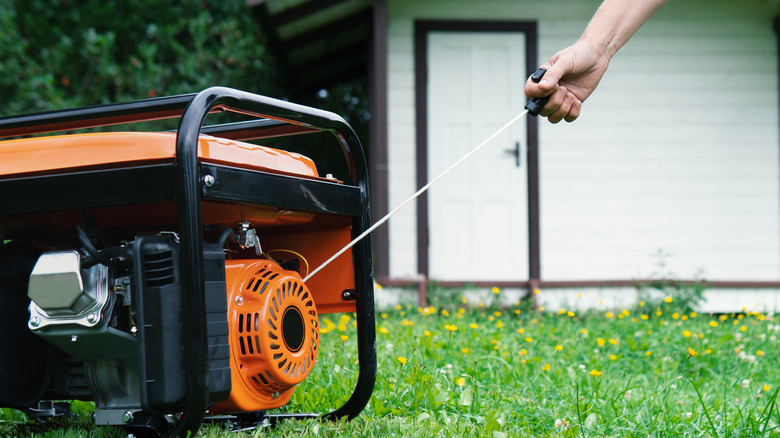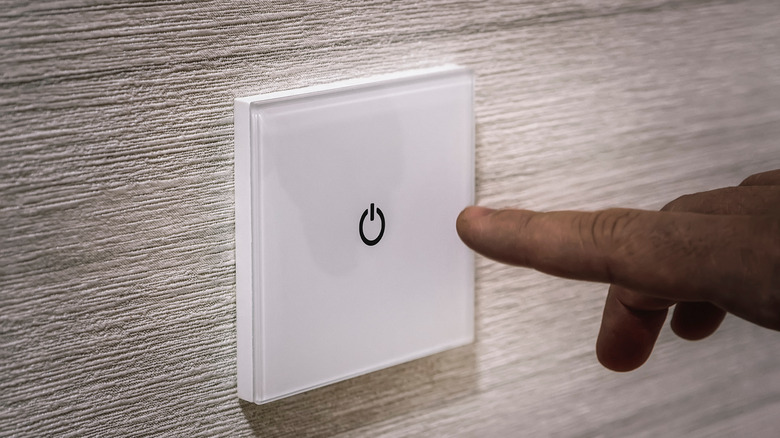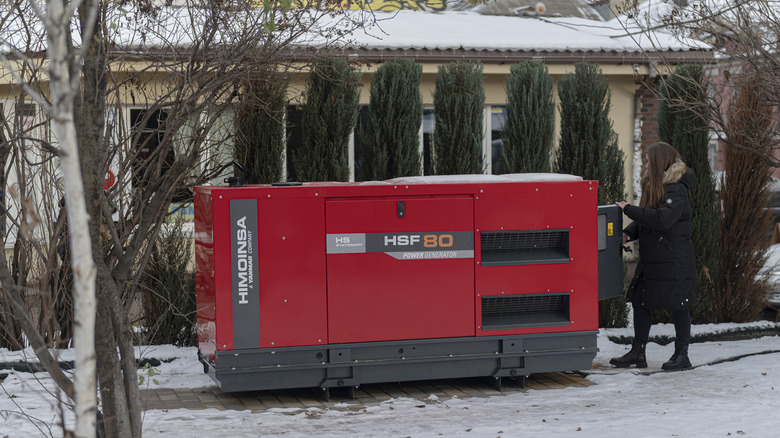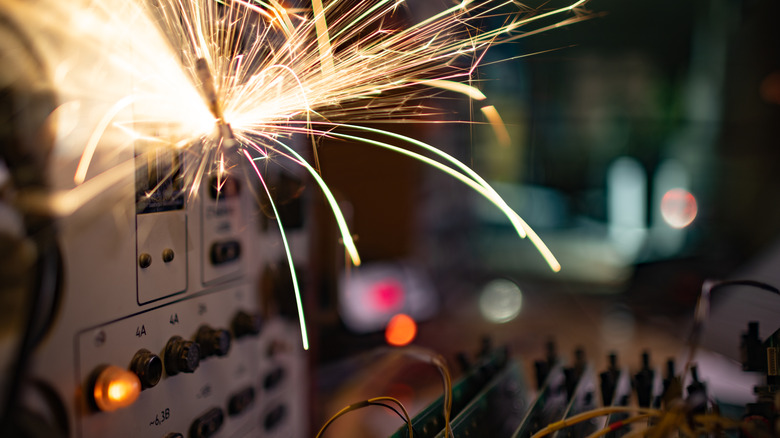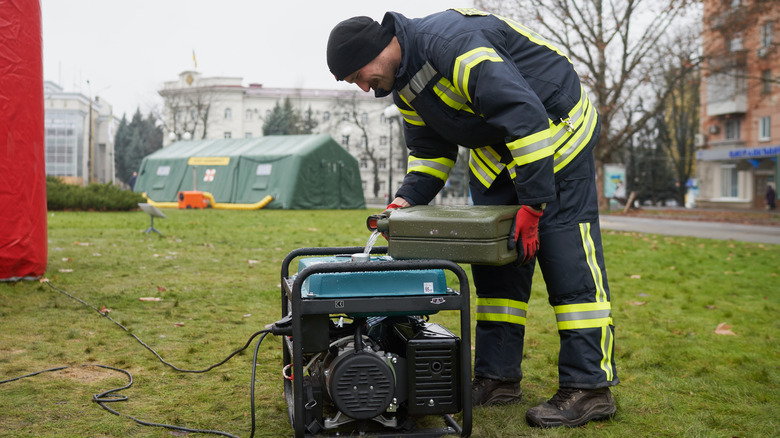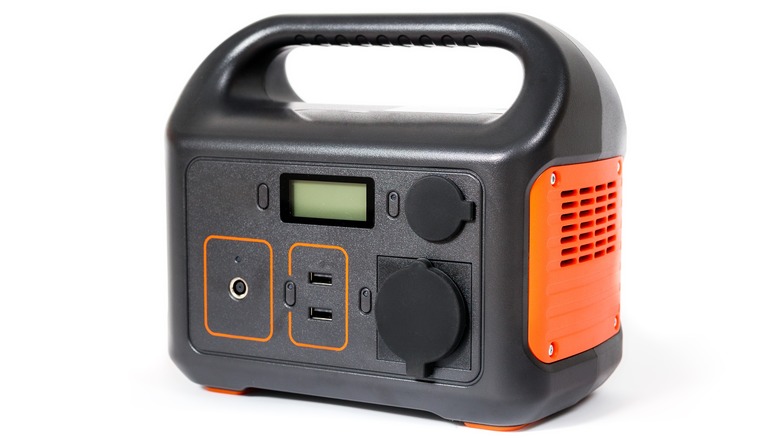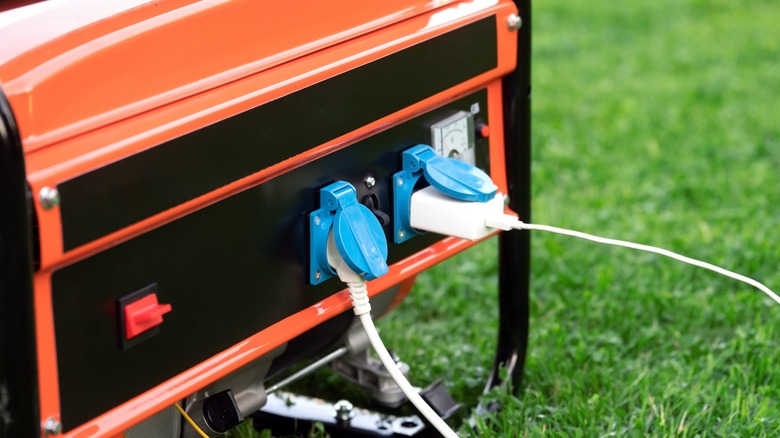Don't Make These Common Mistakes With Your Home Generator
It can be a smart choice to get an emergency generator for winter or an upcoming storm season. According to Happy Hiller, when there's a power outage, you are left very vulnerable. Your home security system stops working and any medical needs that rely on electricity are left unmet. Not to mention that you won't be able to save the food you have in your refrigerator. If you live somewhere that has its fair share of natural disasters, or you often see energy reduction requests to take pressure off the local electric grid, having a generator to use as a backup can keep you safer overall. It is also just more convenient not to worry about what you will do when things go wrong.
A generator isn't a magic electricity-making machine, but rather uses energy reserves from a fuel source to provide temporary electricity (via Generator Source). However, if you don't know what you are doing, using a generator at home can actually cause more problems than it solves. You don't want to leave yourself vulnerable to damaging expensive equipment or possibly injuring yourself. So, here are the most common generator mistakes to avoid.
Using your generator inside
The most hazardous mistake you can ever make while using a home generator is using it inside. This poses an extreme carbon monoxide poisoning risk and can result in your death. According to Got Power, the term "inside" doesn't just cover your home. You should also avoid using a generator in your garage, even if the door is open, as fumes can still build up and hurt you. For safety's sake, place the generator fully outside. The same can be said about the crawl space underneath your home because the fumes can easily build up underneath the floorboards and seep into your home, causing harm.
You can't ever skimp on safety when carbon monoxide is on the table. You can't see, smell, or taste the gas. This leads many to call it "the silent killer." When you breathe it in, the gas takes over all the oxygen in your blood. All of your major organs like your heart and brain rely on oxygen to work. Without an adequate supply, you can lose consciousness in minutes and death can follow not long after. To stay safe, ensure that you always use your generator, or any other gas or fuel-powered device, outside in a well-ventilated area. In addition, consider purchasing a carbon monoxide detector for your main living areas, too.
Buying bad fuel
Just like putting unleaded fuel in a diesel vehicle, filling up your generator with the wrong type of fuel can severely damage it. According to Gen Pro Energy, there are four main types of fuel for common home generators. The first is gasoline, next is propane gas, followed by diesel fuel, and natural gas or liquid natural gas (LNG).
While there are many pros and cons for each fuel type, the most important mistake to avoid is picking the wrong one for the machine you have. Before purchasing fuel for your generator, be sure to read the accompanying safety information thoroughly so you know which type to purchase. Taking another step back, if you only have access to certain types of fuel in your area, be sure the generator you want to purchase is compatible with it before adding the generator to your cart. For example, gasoline and diesel fuel are easily acquired from most service stations at any time of day, while propane or LNG might need to be purchased at a specialty shop or hardware store with limited hours.
Relying on the wrong extension cord
To keep things safe when using your generator, you need to choose the right extension cord. Using one that can handle the electrical load of the machine can reduce the risk of an electrical fire, or overloading an already fragile electrical system during an emergency. According to Portable Generator Grader, one of the main things to look out for when selecting an extension cord is the AWG (American Wire Gauge). Cords come in many different AWG varieties, including A8 up to A16, increasing by two points each time. The smaller the AWG number, the thicker the copper wire inside the rubber tubing of the cord is.
The AWG number impacts how well the cord will work. If you notice your cord isn't allowing your generator to power up fully, it means the ratio of the wattage of your generator to the cord's AWG number is off. In other words, the length of the cord is likely too long relative to its AWG width number. Do not solve this by moving the generator closer to your home, per the risk of carbon monoxide poisoning. Instead, switch to a thicker cord with a lower AWG number, so it can handle more power at once of the same length.
Turning it on and off without thinking
There is a process you should follow to turn your generator on and off to ensure its best use. According to NaijaTechGuide, the only reason not to follow the proper technique is in an emergency situation when your immediate safety is more important than preserving the health of your generator. However, for everyday use, you should start by reading the safety literature that came with your electric generator.
To avoid the potential for electrocution or electrical fire, the safety information is likely to recommend disconnecting the generator from the load before you do anything else. The load is the thing the generator is providing power to, so likely your home. You can disconnect the generator by putting the transfer switch into neutral, per the safety instructions of your specific unit. After you've done this, it's safe to turn off the engine and close the fuel valve. The reason putting the transfer switch into neutral is so important is because touching these other parts of the generator while it is powering an entire building, or even part of one, can expose you to the risk of serious electrical shock.
Forgetting to use a transfer switch
Using the transfer switch on your generator correctly is important because it's the part of the machine that keeps electricity flowing in the right direction. Without it, you are at a high risk of severely injuring yourself. According to Cummins, the transfer switch not only keeps you safe but also keeps power workers safe while fixing up downed lines nearby. This way, everyone gets to go home safely to their families.
There are three main types of transfer switches. They are manual, non-automatic, and automatic. Manual switches must be moved over manually, but are not as common in generators for homes because they can pose a safety risk by not being moved over in time. Non-automatic transfer switches are more like a button in a control room off-site that can move the lever over, but you still have to do it manually. Automatic transfer switches are the most common on home generators, as they don't require action from the user to work properly. However, before using your generator, do your due diligence to discover the type of switch yours has. You also need to know about emergency maintenance and what to do should the transfer switch fail, which should be mentioned in the included safety information packet.
Forgetting to maintain your generator
According to Unified Power, not keeping up with your generator when it is not in use means that you could be literally left out in the cold when you really need it. So you need to maintain your generator just like you would your car. If your machine breaks down due to neglect, you could easily overheat in the sticky post-summer storm atmosphere and lose all the food in your refrigerator. You also might find yourself trying the troubleshoot a non-working generator while it's close to freezing in your own home during a winter storm.
You should take your generator out for a check-up at least once a year. However, if you live somewhere where you end up using a generator more often, like in Florida during hurricane season, for example, give your equipment a general once over before you place it back into storage each time. In between, be sure to reach out to a more experienced technician to perform thorough inspections.
Selecting unqualified repairmen
A generator is typically an expensive piece of equipment, so you don't want to entrust its care to just anyone off the street. Selecting an unqualified repairman can be an expensive mistake. According to Gen-Tech, ensuring your generator is up to snuff is also important because you need to be able to count on it working correctly in case of an emergency. The best way to ensure everything runs smoothly is to hire a qualified technician to do general maintenance on the equipment before there is even a problem. This way, the machine works when you need it most.
When hiring a technician to perform the maintenance, carefully read each potential company's reviews to ensure they have done similar work in the past. A technician with expert-level knowledge and a proactive mindset is a must. You should also hire a technician that is able to explain more general upkeep to you in layman's terms, so you can maintain the unit and perform minor fixes yourself should anything occur between visits.
Disregarding the risk of electrical fire
Fires are a present danger when using a generator. If you behave too casually about safety while using one, you could easily find yourself in the hospital, or worse. According to Fire Fighter Now, using propane, natural gas, or liquid natural gas (LNG) comes with a higher risk of catching on fire than diesel or gasoline, although only slightly. Most of the risk comes from storing the generator incorrectly when not in use or being blasè about safety when you are using the machine.
For example, if you smoke while near your generator, the spark from the ashes of your cigarette can catch the whole thing on fire. If you decide to take your home generator camping, the same could be said for a stray spark from your campfire, too. To avoid this disaster, always pay close attention to your generator's manufacturer's recommendations about safe operating distances. In addition, you don't want to overload the generator with weak extension cords or plug in too many at a time, causing overload. Finally be sure you understand the capabilities of your machine's transfer switch, to avoid a potentially fatal electric back current (via Cummins).
Putting in more fuel while your generator is on
There is an age-old debate as to whether or not it is actually OK to refuel your car while it is still running. Some may say that the inner mechanics of a car are spread out enough that there is no risk of a spark from the engine igniting the fuel. However, when using a generator the consensus is clear — refueling a generator while in use is a fire hazard. Unlike vehicles, generators are compact pieces of equipment, so the risk of sparking is high. According to Home Battery Bank, the risk of severely injuring yourself as well due to this is extreme. There are many ways it could happen, as you might start a gasoline fire, or even possibly cause an explosion that has enough power to end your life and destroy your home.
To stay safe, you will need to follow proper safety procedures in turning off your generator completely. Then, wait at least 10 to 15 minutes for it to cool down. The reason for this waiting period is that the fuel tank is typically close enough to the exhaust that you also risk burning your hands if you do not wait. If you anticipate running your generator for hours on end, consider purchasing one with a larger fuel tank.
Leaving it out in a storm
Exposing a generator to inclement weather can ruin it, which is unfortunate because normally the time when you really need to use a generator is during a storm. According to John C. Flood, to avoid damage you need to plan ahead. You can do this by building an open-air shelter for your generator, like a shed with only one solid wall and a sturdy roof, or setting up a temporary option like a beach tent. Sometimes, the company you purchase your generator from might even sell options that are custom-made to your generator's shape. Remember, you cannot bring your generator inside or operate it in an enclosed space like the garage, even with the door open, due to the risk of carbon monoxide poisoning.
There are a few more things to check on if you are using your generator in a winter storm. This is because snow can build up on the outside of your generator and block the intake functions. To avoid this, place your generator in a custom shelter much like you would if it was raining, but be aware that you might need to go outside and brush it off from time to time (via Be Up!).
Throwing away important information
None of us really like to read the directions, but when operating a generator, they are essential to our safety. Keeping the guidebook that comes with your purchase is an essential part of maintenance. If you don't want to hang on to the paper copy, ensure there is an up-to-date digital copy available on the manufacturer's website. According to Power Continuity, the safety pamphlet will walk you through the basics of getting started, which is especially important to avoid common mistakes if you have never used a generator before.
You will need to check the literature for things like the signs to look out for when you need to check the oil on your generator, as well as tips on how to complete the inspection itself. You'll also need to read up on the main types of damage to inspect your generator for before starting it up each time. It will also provide helpful maintenance advice like how to check the engine intake air filter. While it is true that you can usually look up how to do these things online, you might miss some critical steps if you never read the instructions in the first place.
Thinking you can't use a generator in an apartment
If you are renting an apartment, you might think that you can't purchase a generator because you don't own your home. However, there are still options to protect yourself in case of a power outage. According to Yard Blogger, to safely use a generator in an apartment you need to purchase a battery-powered generator, instead of one that uses gasoline, diesel, or propane. This is because even if you have an outdoor space like a balcony or small porch, it is likely the area isn't big enough to prevent the possibility of carbon monoxide poisoning. In addition, fuel-powered generators can be quite loud, so running them so close to your apartment is likely to disrupt your neighbors, too.
When making your selection, it's helpful to know that some brands call battery-operated generators battery power stations, instead. Essentially, they function as a larger version of the external battery pack you might use to charge your phone on the go. However, you can purchase ones that are powerful enough to run larger items like the refrigerator and your coffee machine.
Forgetting to calculate wattage
Differently sized generators work for different size homes. According to Home Depot, there is an easy formula that you can follow when trying to decide what kind of generator to buy. You simply add the running wattage of items to be powered by the generator to the wattage needed to initially start up these items. This will give you the total wattage needed. To determine the machine for you, go around your home and make a list of the items in your home you are likely to turn on and run using the generator.
If you want to run your house as normal, you will need a large generator as major appliances like refrigerators, HVAC units, and laundry machines require a lot of start-up energy. Smaller things like radios, overhead lights, and toasters would use less power, just by nature of their size. When calculating the total wattage you need, it's a good idea to pad the numbers just a little bit. You don't ever want to be in a situation where you underestimated the amount of energy you need and end up overloading your generator.
